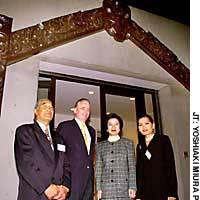To mark half a century of diplomatic representation in Japan, the New Zealand Embassy has marked the installation of an elaborately carved "tomokanga" Maori entranceway.
A tomokanga is a traditional gateway to a Maori "marae," or meeting area, similar to a torii at a Shinto shrine. Marae still play an important role in both contemporary and traditional Maori society in New Zealand, serving as places where people gather for a range of functions.
"Our embassy here in Japan is the New Zealand marae in Japan," Ambassador Phillip Gibson said Wednesday, acknowledging the carving skills of Paratene Te Huia and Tiopira Te Huia, from Mihiroa marae, near Hawkes Bay on the east coast of New Zealand's North Island.
Reading a personal message from Prime Minister Helen Clark, who first visited Japan on the Youth Goodwill Cruise Exchange Program in 1975, the ambassador described Japan as "a very important partner and friend to new Zealand."
"Over the past 50 years, we have built together a relationship which spans the people-to-people, trade and economic and political spheres," the prime minister wrote.
Justice Minister Mayumi Moriyama also attended the dedication ceremony at the embassy, located in Tokyo's Shibuya Ward.
The design of the tomokanga is similar to a traditional "wharenui," or meeting house, a head atop two barge boards and upright posts. The carvings on the entranceway depict the similarities between traditional and modern Japan, including fishing, arts and crafts and agriculture, as well as the sun, which is important in both Japanese and Maori mythology.
New Zealand established full diplomatic ties with Japan in 1952, following the enactment of the San Francisco Peace Treaty, although the relationship had existed long before that official recognition.



















With your current subscription plan you can comment on stories. However, before writing your first comment, please create a display name in the Profile section of your subscriber account page.